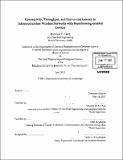Connectivity, throughput, and end-to-end latency in infrastructureless wireless Networks with beamforming-enabled devices
Author(s)
Carey, Matthew F. (Matthew Francis)
DownloadFull printable version (12.27Mb)
Other Contributors
Massachusetts Institute of Technology. Dept. of Electrical Engineering and Computer Science.
Advisor
Vincent W. S. Chan and John M. Chapin.
Terms of use
Metadata
Show full item recordAbstract
Infrastructureless wireless networks are an important class of wireless networks best fitted to operational situations with temporary, localized demand for communication ability. These networks are composed of wireless communication devices that autonomously form a network without the need for pre-deployed infrastructure such as wireless base-stations and access points. Significant research and development has been devoted to mobile ad hoc wireless networks (MANETs) in the past decade, a particular infrastructureless wireless network architecture. While MANETs are capable of autonomous network formation and multihop routing, the practical adoption of this technology has been limited since these networks are not designed to support more than about thirty users or to provide the quality of service (QoS) assurance required by many of the envisioned driving applications for infrastructureless wireless networks. In particular, communication during disaster relief efforts or tactical military operations requires guaranteed network service capabilities for mission-critical, time-sensitive data and applications. MANETs may be frequently disconnected due to device mobility and mismatches between routing and transport layer protocols, making them unsuitable for these scenarios. Network connectivity is fundamentally important to a network designed to provide QoS guarantees to the end-user. Without network connectivity, at least one pair of devices in the network experiences zero sustainable data rate and infinite end-to-end message delay, a catastrophic condition during a search and rescue mission or in a battlefield. We consider the use of wireless devices equipped with beamforming-enabled antennas to expand deployment regimes in which there is a high probability of instantaneous connectivity and desirable network scalability. Exploiting the increased communication reach of directional antennas and electronic beam steering techniques in fixed rate systems, we characterize the probability of instantaneous connectivity for a finite number of nodes operating in a bounded region and identify required conditions to achieve an acceptably high probability of connectivity. Our analysis shows significant improvements to highly-connected regimes of operation with added antenna directivity. Following the characterization of instantaneous network connectivity, we analyze the achievable network throughput and scalability of both fixed and variable rate beamforming-enabled power-limited networks operating in a bounded region. Our study of the scaling behavior of the network is concerned with three QoS metrics of central importance for a system designed to provide service assurance to the end-user: achievable throughput, end-to-end delay (which we quantify as the number of end-to-end hops), and network energy consumption. We find that the infrastructureless wireless network can achieve scalable performance that is independent of end-user device density with high probability, as well as identify the existence of a system characteristic hopping distance for routing schemes that attain this scaling-optimal behavior. Our results also reveal achievable QoS performance gains from the inclusion of antenna directivity. Following these insights, we develop a scalable, heuristic geographic routing algorithm using device localization information and the characteristic hopping distance guideline that achieves sub-optimal but high network throughput in simulation.
Description
Thesis (S.M.)--Massachusetts Institute of Technology, Dept. of Electrical Engineering and Computer Science, 2011. Cataloged from PDF version of thesis. Includes bibliographical references (p. 181-188).
Date issued
2011Department
Massachusetts Institute of Technology. Department of Electrical Engineering and Computer SciencePublisher
Massachusetts Institute of Technology
Keywords
Electrical Engineering and Computer Science.